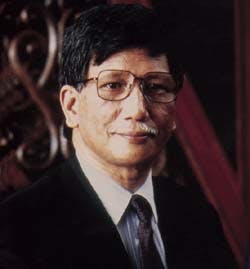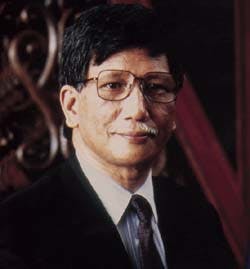SOUTHEAST ASIA Pertamina's G.A.S. Nayoan reveals Indonesia's marketing of Natuna Field is "on time and on track"
Dev George
Managing Editor
G.A.S. Nayoan
Natuna Island
In an exclusive interview conducted at Pertamina's headquarters in Jakarta, G.A.S. Nayoan, Senior Executive Vice President, chairman of the executive board for the Natuna Gas Project, and head of gasfield development, spoke optimistically about development of the massive Natuna Field and Indonesia's program for exploration and development of its frontier and deepwater zones.
The Natuna Field was discovered in 1973. Located in the Natuna Sea approximately 225 km northeast of Natuna Island in water 145 meters deep, the field lies about 825 km northeast of Singapore and 1300 km north of Jakarta. Its reservoir contains recoverable hydrocarbon reserves estimated at 45 tcf gas out of a total gas volume estimated to be 210 tcf, including carbon dioxide, which comprises 71% of the total gas.
The Natuna LNG Project is a program for offshore gas production and treating and liquefaction onshore Natuna Island. The produced LNG is to be made available to buyers in Japan, Korea, Taiwan, and Thailand. The Natuna Island LNG plant will be Indonesia's third, after Arun in northern Sumatra and Bontang in East Kalimantan. Pertamina, the national oil company of Indonesia and the world's largest supplier of LNG, and Esso Exploration and Production Natuna, a subsidiary of Exxon Corporation, have a production sharing contract for Natuna Field.
Development of Natuna has been postponed for some time as first details of the development contract and then marketing of Natuna's LNG were completed.
Selling Natuna
"From the time we get a commitment from the Japanese and any other potential buyers, it will be about 8.2 years before any LNG will be delivered. That makes the Natuna Project coming onstream in about 2003-04. Why so long? Because it will take about six years just to build and install the system of gas treatment platforms and the other facilities and pipelines. It is an enormous complex, a monster - I call it a beast.
"The treatment platform will be the size of the Petronas Building in Kuala Lumpur, from the bottom of the sea to the top, it's more than 240 meters from the bottom of the sea to the top of the incinerator. This takes a long time. So when we're asked why we can't get pipeline gas earlier, I have to answer that from East Natuna, if we don't have the treatment platforms, we have CO2. We can't just expel it into the atmosphere, we have to transport it 35-75 km and inject it into subsea aquifers.
"Everyone is competing so much for the markets now for gas, LNG in particular, that even though you have enormous amounts, you've got a time problem that forces you to capture as much of that market as possible. Our position is, the forecasters say that East Asia will have a negative LNG supply in the 2010, starting in 2005, but that exports are going to go up. All the experts are saying that, but somebody has to fill this cost gap ratio, maybe around 2001 or 2003. Malaysia is pushing its production of LNG, and so is Australia. And there is even the possibility of LNG from Russian Siberia and Alaska. These are all our competitors, but there will be enough for us all.
"Natuna's LNG will be going to Japan, Korea, maybe Thailand and Taiwan. And, of course, there is China in the background, not yet a customer, but probably someday.
"The Japanese are, of course, our first customer, and it is with them that we have been negotiating. They say let's talk about whether you are in the queue, meaning are we in the queue of the suppliers? So we moved into the forefront of suppliers with cost estimations.
"We are in the queue already, but it took some time. The Japanese always negotiate very systematically. And they say are your reserves right? So I say we are producing 55 million tons. Reserves are always going to undergo the usual routine, traditional process of appraisals. We fulfilled that. So, okay, you are still in the queue, you are good in your reserves. We accept that. And now they say, we know that there are problems with CO2. How are you going to handle that?
"There you go. The first thing is how are you going to separate it? We have explained the processing and treatment to them, and we took them to other Esso processing facilities, and they said okay, we are satisfied. Now how are you going to store it and how are you going to dispose of the waste gas? Are you going to flair it or are you going to use it?
"So we said, no, we can't use it, so we have to store it. We made a study and we presented to them, and storage was approved. Finally, they ask how we are going to inject it, and we explain how its done elsewhere.
"So that's the way it has gone, bit by bit, one month by one month, until we answered all the questions, and then they said, okay, we're satisfied with those things, so now let's talk commercial. In Pertamina, we talk about everything, including the price, because, after all, we have to get the money from them, otherwise there would be no work done. That's why it has taken a year to reach this point in our discussions, but one year, is not so much. We are already talking commercial. So, in our opinion, we are on time and we are on track.
"We have finalized the parts, the CO2, and are now in the commercial part, negotiating the price. We're doing that now. We offer at the highest price and they have the lowest price. That's why we appreciate each other. That's why we have a conditional good corporation with the Japanese buyers, because everything is clear It's a business arrangement.
"The price is high, but we are trying to give them information on how we are going to reduce it. There are three ways we believe we can lower the price: first through operations and appraisal. In operations, we are going to do what other people are doing in the North Sea and in similar projects. We are going to do form strategic alliances. Furthermore, we alliances, the alliance concept. Second, we will be drawing upon CRINE principles, as they are doing in the North Sea, and finally, third, we have our 'GO's, Golden Opportunities. These are opportunities to keep the costs down that start with the offshore drillers and the suppliers of materials, the piler, and so on. It includes good loans for the fabricators from the client, from the countries that are going to supply them, and so on. Everything is geared to reducing the cost, because we know that we have to compete. We never said it was going to be easy, but we have tried to anticipate any problems.
"President Suharto even signed a new presidential decree to facilitate the project because it is so big."
Frontier & deepwater
"Well maybe we might talk a little bit about, and this is sort of changing the subject a little bit, much of the talk about Indonesia has been well, some time ago, your terms were difficult. And foreign operators were sometimes reluctant to come here for that reason. Now, it appears that you've got a very attractive set of terms for the frontier and deep water.
"Yes, at the present moment for frontier and deep water, we have for gas a 60-40 split, 60 for the government, 40 for the operator. For oil, it is 65 and 35. This is for areas which are classified as frontier and especially for the area in the eastern part of Indonesia. These terms, I think, are very effective for everybody, but we realize also that the whole world is doing exploration in their backyards. All countries are saying, look, we need energy for our development in oil and gas. We can import it, but let's look first in our backyard. The United States is not looking in its backyard, it's looking in everybody's backyards.
"Today, the world is the marketplace for exploration. Almost all countries are trying to attract exploration money into their own areas, that's why we realize that much of the exploration money is going to somebody else. We cannot say, look you cannot go to Myanmar or to Tanzania, you have to come to us. We cannot do that. It's a matter of the people who have the money and who you want to invest.
"The competition is heavy. The developing countries are actually now developing, and they need to invest in their energy. It's logical.
"It seems the main drawback is the lack of infrastructure in many of these areas, however, and that's the reason a lot of times operators are reluctant to go into a place like Irian Jaya, for example, even when the prospect looks very good.
"When you are a global company, you want to diversify your options, and that means you are going to do the million miles, you'll go to Vietnam. So you reduce a little bit your geological exposure, and increase the political exposure, and we understand that. "Although maybe our duality in Irian Jaya is better as compared to the Philippines, for instance. Well, you have a global company, you say look I don't want to invest too much in Indonesia. Let's diversify the exploration portfolio and go to somebody else. We recognize this, but we also recognize the principle that everything is production and exploration. You've got to have exploration to get production.
"At this time, our production is pretty good, at the moment, we are producing at a 10-15 year high of 1.5 million b/d. Our highest was about 1.6 million b/d in 1976, so we are approaching 15 years ago. It appears then, that we are fulfilling our potential to produce. "We are going up. And the idea is that to keep it up and maintain production, we have to do more exploration. And we're encouraging more of a fast-track type of route for discoveries, such as is being done in the Conoco area. It seems to be a very good way to get something moving, to get production going quickly, if conditions allow it. That seems to be a major trend around the world.
"We are trying to do that with Irian Jaya, for instance, where we have got a lot of gas, a lot of condensate. We are trying to produce the gas and the condensate, but, of course, where should the gas go? We drain the condensate, then what do we do with the gas? It would be nice if we could flare it, but that's impossible. Or we can use it, and in Irian Jaya, they are going to use it because there is no industry."
Copyright 1996 Offshore. All Rights Reserved.

